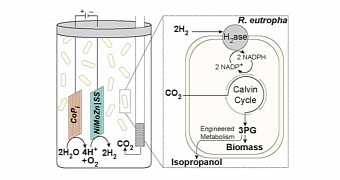Solar cells may be the primary means of turning light into electrical energy, but scientists around the world are always looking into alternative ways of harnessing the potential of that virtually inexhaustible source of power.
Since biological computers are so popular in science fiction, there are plenty of people looking into ways for how living things could be used to generate power, among other things.
In fact, quite a few of them have come together to create what they have dubbed the “bionic leaf,” a device that uses wild-type and engineered bacteria to convert solar energy into a liquid fuel.
The bionic leaf
The name is, perhaps, not exactly representative of the device itself, since it is not so much based on photosynthesis as it is on Ralstonia eutropha (that's the scientific name of the bacteria).
In this system, catalysts that are made of earth-abundant metals are used to perform water-splitting catalysis with low overpotential water splitting.
This results in the freeing of hydrogen atoms which are then fed to the bacteria, to be combined with carbon dioxide by an enzyme that takes the hydrogen back to protons and electrons.
The water-splitting anode is made of cobalt phosphate (CoPi) while the cathodes are built from NiMoZn or stainless-steel mesh.
O2 is generated and, in turn, used to fix carbon to biomass in wild-type (wt) Ralstonia eutropha H16 and to isopropanol in an engineered strain of R. eutropha, Re2133-pEG12. All the while, new pathways in the bacterium are metabolically engineered to make isopropanol.
In fewer words, this leads to the creation of more cells (biomass). Altogether, the process generates liquid fuels by reducing carbon dioxide via water splitting.
The work is the result of effort on the part of scientists from Harvard University’s Faculty of Arts and Sciences, Harvard Medical School and the Wyss Institute for Biologically Inspired Engineering. A full study was published in Proceedings of the National Academy of Sciences (PNAS).
Practical applications
The research shows that inorganic and biological materials can be interfaced to achieve solar-to-fuels storage schemes that the individual systems cannot achieve in isolation.
Further research is being done into increasing the bionic leaf's ability to turn solar energy into biomass by optimizing both the bacteria and the catalyst. Efficiency is at the natural 1% right now, but the goal is 5%.

 14 DAY TRIAL //
14 DAY TRIAL //